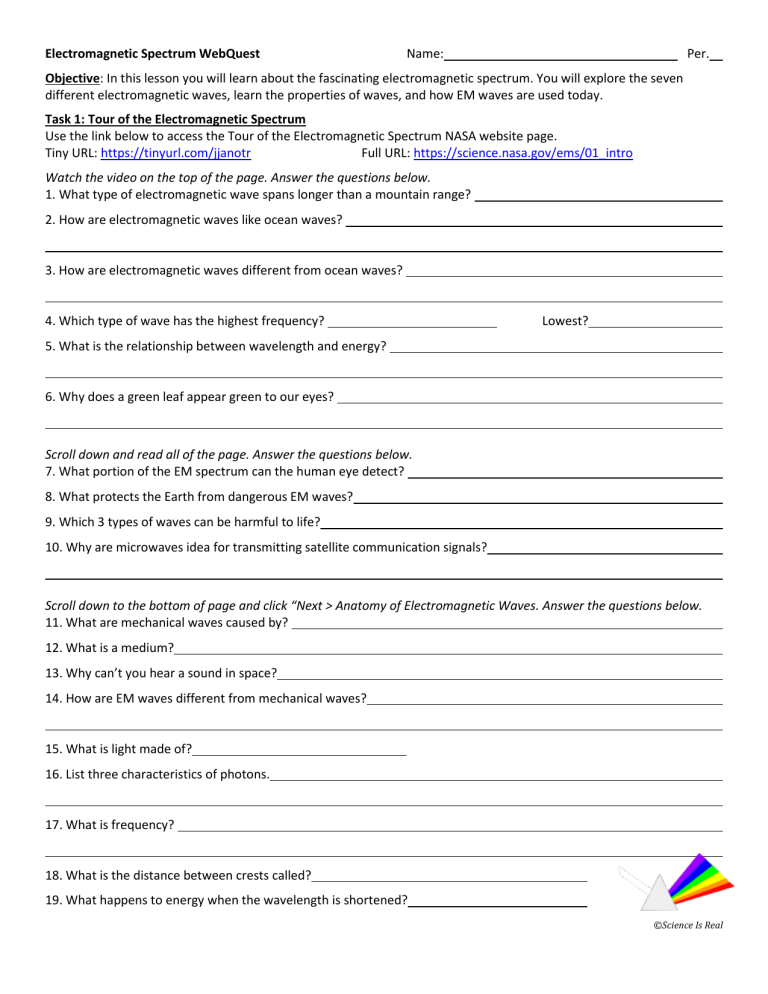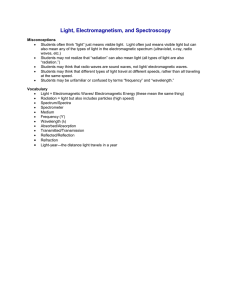
Electromagnetic Spectrum WebQuest Name: Per. Objective: In this lesson you will learn about the fascinating electromagnetic spectrum. You will explore the seven different electromagnetic waves, learn the properties of waves, and how EM waves are used today. Task 1: Tour of the Electromagnetic Spectrum Use the link below to access the Tour of the Electromagnetic Spectrum NASA website page. Tiny URL: https://tinyurl.com/jjanotr Full URL: https://science.nasa.gov/ems/01_intro Watch the video on the top of the page. Answer the questions below. 1. What type of electromagnetic wave spans longer than a mountain range? 2. How are electromagnetic waves like ocean waves? 3. How are electromagnetic waves different from ocean waves? 4. Which type of wave has the highest frequency? Lowest? 5. What is the relationship between wavelength and energy? 6. Why does a green leaf appear green to our eyes? Scroll down and read all of the page. Answer the questions below. 7. What portion of the EM spectrum can the human eye detect? 8. What protects the Earth from dangerous EM waves? 9. Which 3 types of waves can be harmful to life? 10. Why are microwaves idea for transmitting satellite communication signals? Scroll down to the bottom of page and click “Next > Anatomy of Electromagnetic Waves. Answer the questions below. 11. What are mechanical waves caused by? 12. What is a medium? 13. Why can’t you hear a sound in space? 14. How are EM waves different from mechanical waves? 15. What is light made of? 16. List three characteristics of photons. 17. What is frequency? 18. What is the distance between crests called? 19. What happens to energy when the wavelength is shortened? ©Science Is Real Task 2: Tour Of The Electromagnetic Spectrum Interactive Use the link below to access the “Electromagnetic Spectrum Tour” from the PBS Nova website. Fill in the table below as you move through the tour. Tiny URL: https://tinyurl.com/3le3sf7 Full URL: http://www.pbs.org/wgbh/nova/physics/electromagnetic-spectrum.html Type EM Wave Description of Wave Example of How This Wave is Used 20. Radio Wave 21. Microwave 22. Infrared Radiation 23. Visible Light 24. Ultraviolet Light 25. X-Rays 26. Gamma Rays Task 3: Electromagnetic Spectrum Interactive Use the link the below to access the “Electromagnetic Spectrum” interactive from the EarthGuide website. Move the slider back and forth to learn more about each type of EM wave. Tiny URL: https://tinyurl.com/7uqztgo Full URL: http://earthguide.ucsd.edu/eoc/special_topics/teach/sp_climate_change/p_emspectrum_interactive.html 27. What has a longer wavelength – Ultraviolet Light or Visible Light? 28. Which type of wave on the EM spectrum is used in night photography, some remote controls, and temperature imaging? 29. Which contains more energy – Infrared Radiation or X-Rays? 30. Which has a higher frequency – Visible Light or Microwaves? 31. If you decrease the frequency of the wave, what happens to its level of energy? ©Science Is Real Task 4: Looking Through Galactic Space Clouds Use the link below to watch the Electromagnetic Spectrum: Looking Through Galactic Space Clouds video by the Physics Institute. Answer the questions below as you watch. Tiny URL: https://tinyurl.com/y2l46khb Full URL: https://www.youtube.com/watch?v=5GIvktBSxvw 32. Why is Betelgeuse red and Rigel blue? 33. Are red or blue stars hotter? 34. Why is looking at the infrared energy in an object useful to scientists? 35. What advantage does a radio telescope have? 36. What is dust in astronomy made of? 37. What will the dust in space become in millions of years? Task 5: Astronomical Images In Different EM Spectrum Wavelength Use the link below to access the “Astronomical Images in Different Wavelengths” interactive from the PBS Learning Media™ website. Click the launch button to explore the different telescope images taken using different EM waves. As you explore, complete the following table. Tiny URL: https://tinyurl.com/lrnn3xp Full URL: http://www.pbslearningmedia.org/resource/phy03.sci.ess.eiu.chandra/astronomical-images-in-different-wavelengths/ Name of Object 2 Facts About Object What Was Your Favorite Image of this object and WHY? 38. Cassiopeia A 39. Centaurus A 40. Crab Nebula 41. Eta Carinae 42. Milky Way ©Science Is Real





